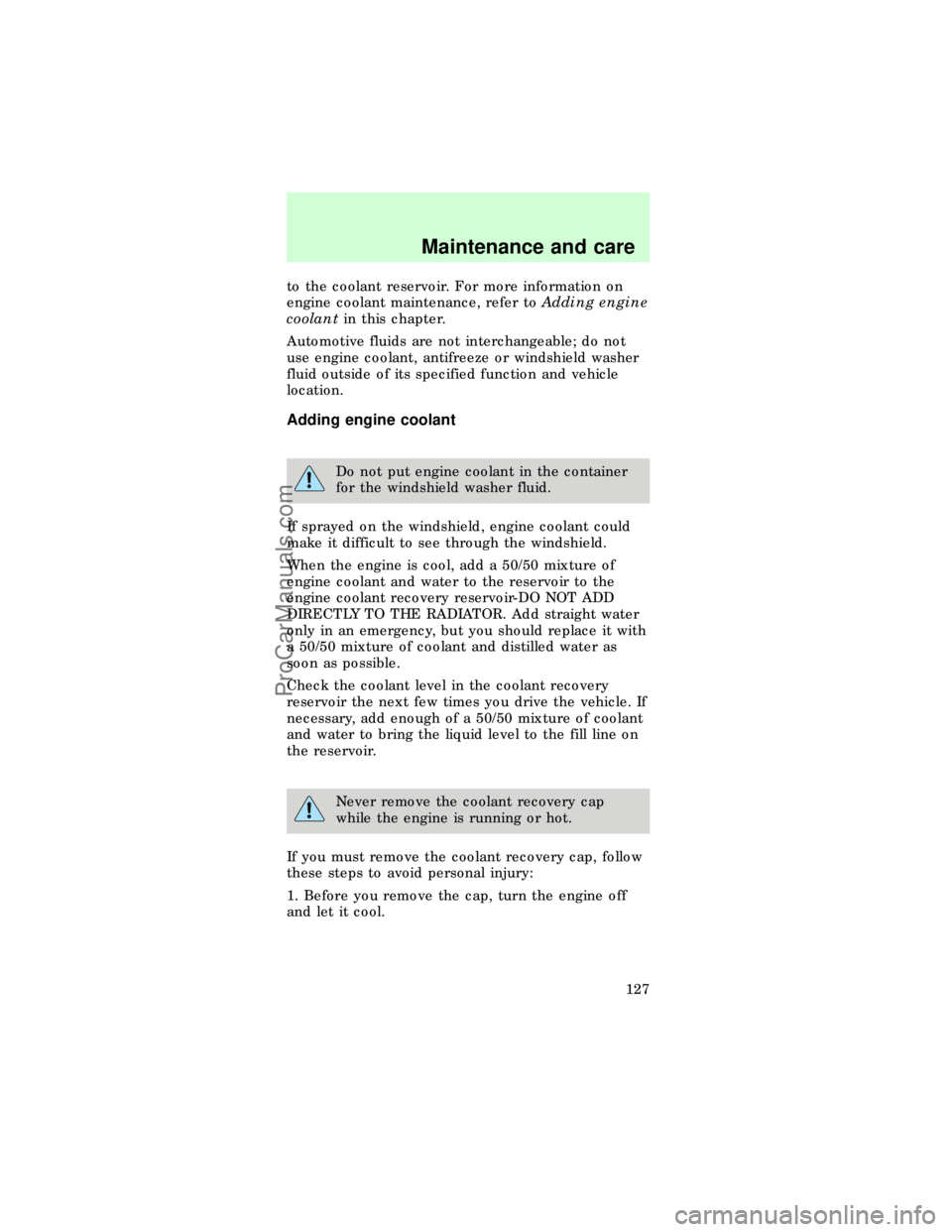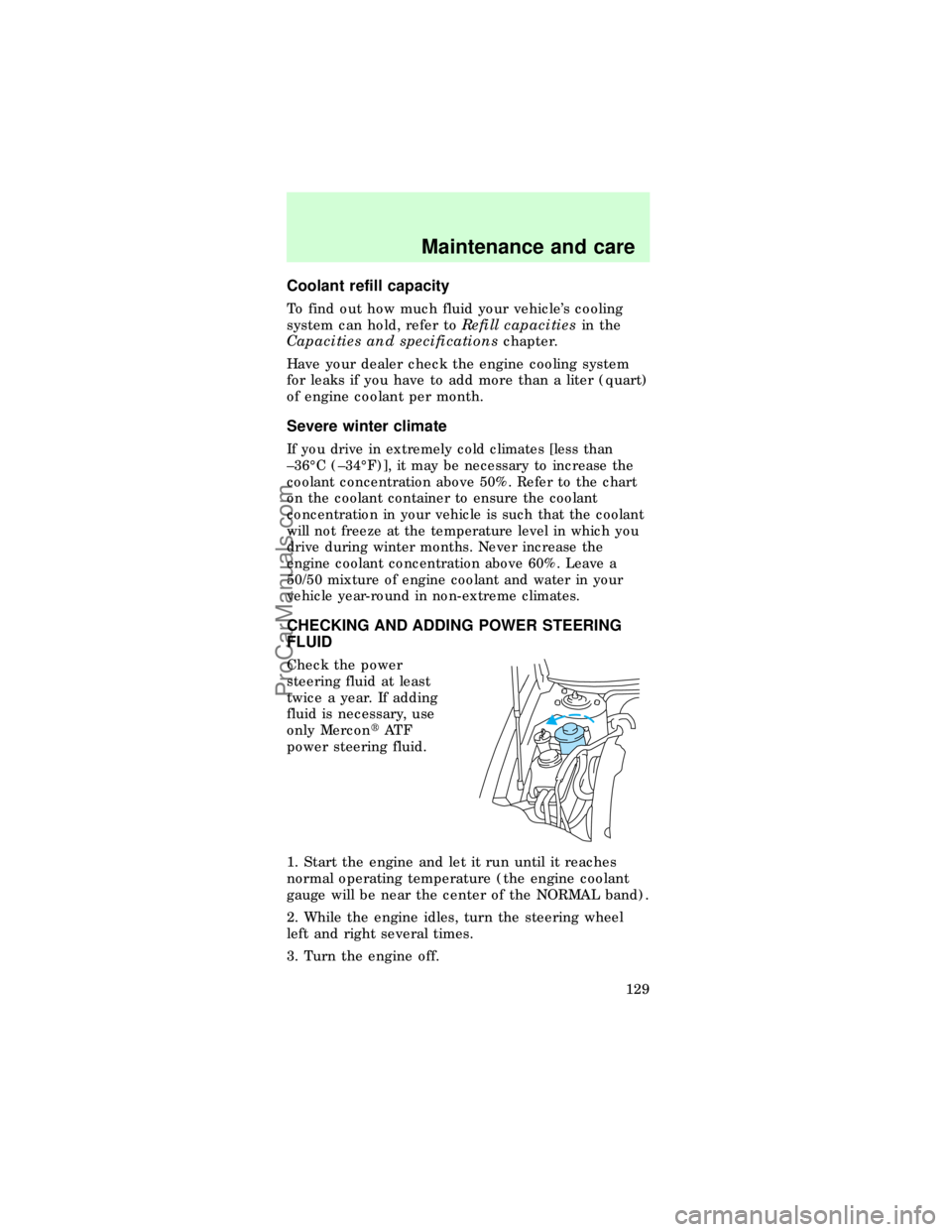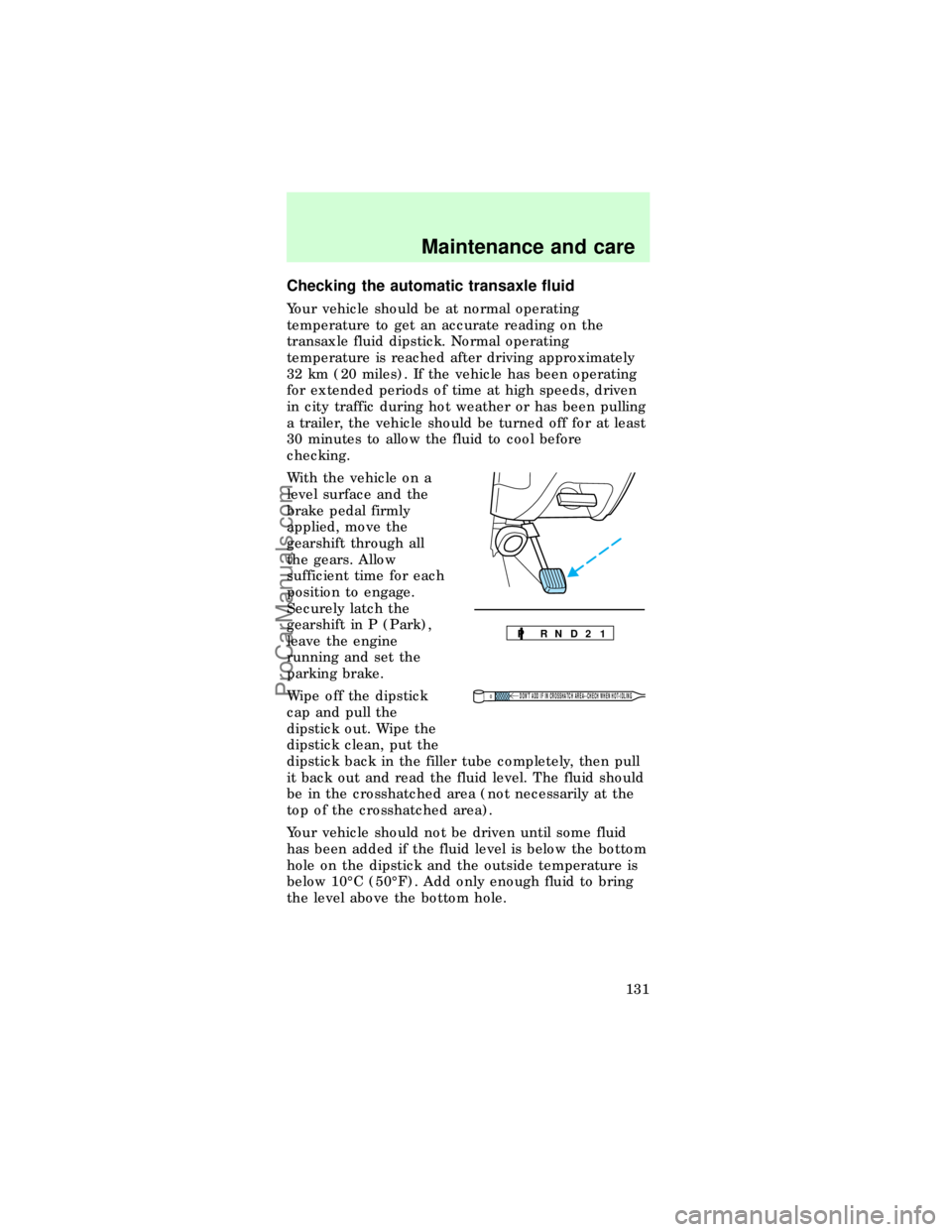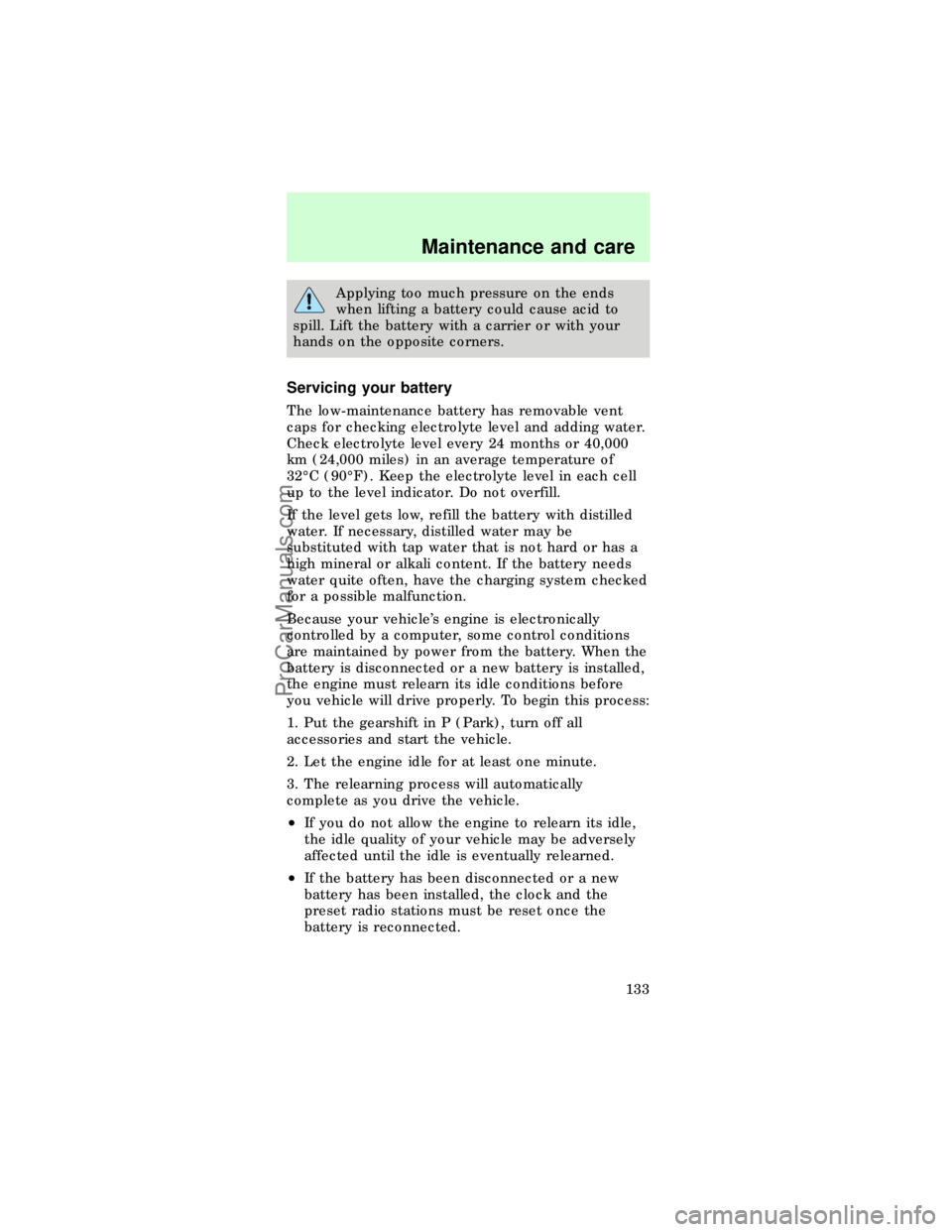check engine FORD TAURUS 1997 User Guide
[x] Cancel search | Manufacturer: FORD, Model Year: 1997, Model line: TAURUS, Model: FORD TAURUS 1997Pages: 167, PDF Size: 1.48 MB
Page 126 of 167

to the coolant reservoir. For more information on
engine coolant maintenance, refer toAdding engine
coolantin this chapter.
Automotive fluids are not interchangeable; do not
use engine coolant, antifreeze or windshield washer
fluid outside of its specified function and vehicle
location.
Adding engine coolant
Do not put engine coolant in the container
for the windshield washer fluid.
If sprayed on the windshield, engine coolant could
make it difficult to see through the windshield.
When the engine is cool, add a 50/50 mixture of
engine coolant and water to the reservoir to the
engine coolant recovery reservoir-DO NOT ADD
DIRECTLY TO THE RADIATOR. Add straight water
only in an emergency, but you should replace it with
a 50/50 mixture of coolant and distilled water as
soon as possible.
Check the coolant level in the coolant recovery
reservoir the next few times you drive the vehicle. If
necessary, add enough of a 50/50 mixture of coolant
and water to bring the liquid level to the fill line on
the reservoir.
Never remove the coolant recovery cap
while the engine is running or hot.
If you must remove the coolant recovery cap, follow
these steps to avoid personal injury:
1. Before you remove the cap, turn the engine off
and let it cool.
Maintenance and care
127
ProCarManuals.com
Page 128 of 167

Coolant refill capacity
To find out how much fluid your vehicle's cooling
system can hold, refer toRefill capacitiesin the
Capacities and specificationschapter.
Have your dealer check the engine cooling system
for leaks if you have to add more than a liter (quart)
of engine coolant per month.
Severe winter climate
If you drive in extremely cold climates [less than
±36ÉC (±34ÉF)], it may be necessary to increase the
coolant concentration above 50%. Refer to the chart
on the coolant container to ensure the coolant
concentration in your vehicle is such that the coolant
will not freeze at the temperature level in which you
drive during winter months. Never increase the
engine coolant concentration above 60%. Leave a
50/50 mixture of engine coolant and water in your
vehicle year-round in non-extreme climates.
CHECKING AND ADDING POWER STEERING
FLUID
Check the power
steering fluid at least
twice a year. If adding
fluid is necessary, use
only MercontAT F
power steering fluid.
1. Start the engine and let it run until it reaches
normal operating temperature (the engine coolant
gauge will be near the center of the NORMAL band).
2. While the engine idles, turn the steering wheel
left and right several times.
3. Turn the engine off.
Maintenance and care
129
ProCarManuals.com
Page 129 of 167

3.0L Vulcan engine
4. Check the fluid level
on the dipstick. It
should be between the
arrows in the FULL
HOT range. Do not add
fluid if the level is
within this range.
5. If the fluid is low, add fluid in small amounts,
continuously checking the level until it reaches the
FULL HOT range. Be sure to put the dipstick back
in the reservoir.
3.0L Duratec engine and 3.4L SHO engine
4. Check the fluid level
in the reservoir. It
should be between the
MIN and MAX lines. Do
not add fluid if the
level is within this
range.
5. If the fluid is low, add fluid in small amounts,
continuously checking the level until it reaches the
range between the MIN and MAX lines. Be sure to
put the cap back on the reservoir.
AUTOMATIC TRANSAXLE FLUID
Under normal circumstances, the transaxle fluid
does not need to be checked. Refer to theService
Guidefor fluid replacement intervals. If the
transaxle is not working properly Ð for instance, the
transaxle may slip or shift slowly or even some fluid
leakage (red fluid under the vehicle) Ð the fluid
should be checked.
FULL HOT
MINMAX
Maintenance and care
130
ProCarManuals.com
Page 130 of 167

Checking the automatic transaxle fluid
Your vehicle should be at normal operating
temperature to get an accurate reading on the
transaxle fluid dipstick. Normal operating
temperature is reached after driving approximately
32 km (20 miles). If the vehicle has been operating
for extended periods of time at high speeds, driven
in city traffic during hot weather or has been pulling
a trailer, the vehicle should be turned off for at least
30 minutes to allow the fluid to cool before
checking.
With the vehicle on a
level surface and the
brake pedal firmly
applied, move the
gearshift through all
the gears. Allow
sufficient time for each
position to engage.
Securely latch the
gearshift in P (Park),
leave the engine
running and set the
parking brake.
Wipe off the dipstick
cap and pull the
dipstick out. Wipe the
dipstick clean, put the
dipstick back in the filler tube completely, then pull
it back out and read the fluid level. The fluid should
be in the crosshatched area (not necessarily at the
top of the crosshatched area).
Your vehicle should not be driven until some fluid
has been added if the fluid level is below the bottom
hole on the dipstick and the outside temperature is
below 10ÉC (50ÉF). Add only enough fluid to bring
the level above the bottom hole.
P R N D 2 1
DON’T ADD IF IN CROSSHATCH AREA--CHECH WHEN HOT-IDLING
Maintenance and care
131
ProCarManuals.com
Page 132 of 167

Applying too much pressure on the ends
when lifting a battery could cause acid to
spill. Lift the battery with a carrier or with your
hands on the opposite corners.
Servicing your battery
The low-maintenance battery has removable vent
caps for checking electrolyte level and adding water.
Check electrolyte level every 24 months or 40,000
km (24,000 miles) in an average temperature of
32ÉC (90ÉF). Keep the electrolyte level in each cell
up to the level indicator. Do not overfill.
If the level gets low, refill the battery with distilled
water. If necessary, distilled water may be
substituted with tap water that is not hard or has a
high mineral or alkali content. If the battery needs
water quite often, have the charging system checked
for a possible malfunction.
Because your vehicle's engine is electronically
controlled by a computer, some control conditions
are maintained by power from the battery. When the
battery is disconnected or a new battery is installed,
the engine must relearn its idle conditions before
you vehicle will drive properly. To begin this process:
1. Put the gearshift in P (Park), turn off all
accessories and start the vehicle.
2. Let the engine idle for at least one minute.
3. The relearning process will automatically
complete as you drive the vehicle.
²If you do not allow the engine to relearn its idle,
the idle quality of your vehicle may be adversely
affected until the idle is eventually relearned.
²If the battery has been disconnected or a new
battery has been installed, the clock and the
preset radio stations must be reset once the
battery is reconnected.
Maintenance and care
133
ProCarManuals.com
Page 143 of 167

Never use a metal exhaust collector when you
service your vehicle. If the metal collector contacts
any of your vehicle's plastic trim or bumper parts
they could melt or deform.
Do not drive your vehicle if it does not operate
properly. See your dealer if the engine runs on for
more than five seconds after you shut it off or if it
misfires, surged, stalls or backfires.
Information about your vehicle's emission system is
on the Vehicle Emission Control Information decal
located on or near the engine. This decal identifies
engine displacement and gives some tune up
specifications.
Readiness for inspection/maintenance testing
In some localities, it may become a legal
requirement to pass an Inspection/Maintenance (I/M)
test of the On-board Diagnostic (OBD) II system. If
the vehicle's powertrain system or its battery has
just been serviced, the OBD II system is reset to a
not ready for I/M testing condition. To prepare for
I/M testing, the law specifies that additional mixed
city and highway driving is required to complete the
check of the OBD II system.
The driving modes required to reach the ready
condition consist of a minimum of 30 minutes of city
and highway driving as described below:
²At least twenty minutes driving in stop and go,
city type traffic with at least four idle periods.
²At least ten minutes of driving on an expressway
or highway.
Before completing the above driving modes, the
engine must be warmed up and at operating
temperature. Once started, the vehicle must not be
turned off during these driving modes.
EXTERIOR LAMPS
It is a good idea to check the operation of the
following lights frequently:
Maintenance and care
144
ProCarManuals.com
Page 161 of 167

Engine data
Torque 170 @ 3250
rpm200 @ 4500
rpm230 @ 4800
rpm
Required
fuel grade87 octane 87 octane 91 octane
Firing order 1-4-2-5-3-6 1-4-2-5-3-6 1-5-4-2-6-
3-7-8
Spark plug
gap1.07-1.17
mm
(0.042-0.046
inch)1.07-1.17
mm
(0.042-0.046
inch)1.07-1.17
mm
(0.042-0.046
inch)
Ignition
systemDIS DIS DIS
Valve
clearance
cold inlet
exhaust0:
Maintenance
free0:
Maintenance
freeCheck and
adjust as
necessary
at 160,000
km
(100,000
miles)
VEHICLE DIMENSIONS
Vehicle
dimensions
mm (in.)Sedan Wagon
(1) Overall
length5016.5 (197.5) 5069.8 (199.6)
(2) Overall
width1854.2 (73.0) 1854.2 (73.0)
(3) Overall
height1399.5 (55.1) 1463.0 (57.6)
(4) Wheelbase 2755.9 (108.5) 2755.9 (108.5)
(5) Track -
Front1564.6 (61.6) 1564.6 (61.6)
Capacities and specifications
162
ProCarManuals.com